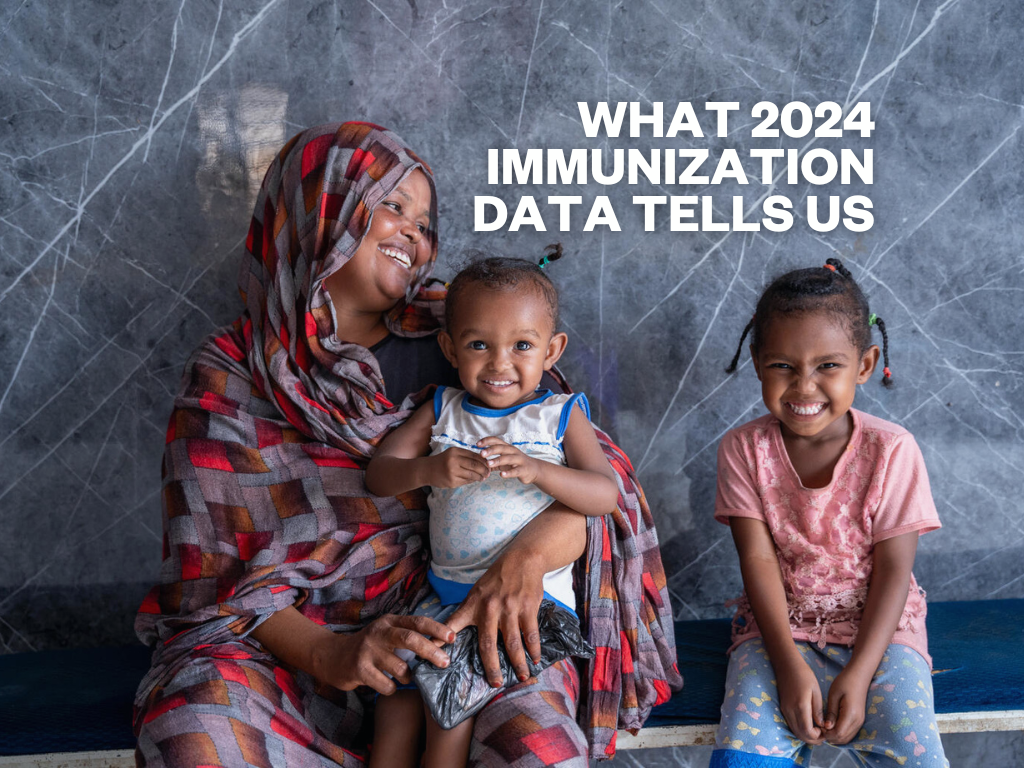Unpacking the Immunization Data of 2024
Just last week, WHO and UNICEF released their 2024 estimates of national immunization coverage. And this year's annual snapshot paints a clear picture: business as usual won’t be enough.

Each summer, the WHO and UNICEF release a holy grail of global immunization data: the WHO/UNICEF Estimates of National Immunization Coverage, or WUENIC (pronounced woo-nick). This annual report offers a snapshot of how the world is doing in protecting its youngest citizens from vaccine-preventable diseases. The 2024 data, released just last week, paints a picture of slow but steady progress—alongside stubborn challenges and novel threats with the potential to unravel years of hard-won progress.
Progress is Progress
Starting with some good news: in 2024, an estimated 115 million infants around the globe—that’s 89% of the world’s total—received at least one dose of the diphtheria, tetanus, and pertussis (DTP) vaccine, and 109 million—that’s 85%—completed the full three-dose series. The DTP vaccine is considered a cornerstone of pediatric immunization programs worldwide, so the WHO aims for at least 90% global coverage and uses DTP vaccination rates as a general indicator of access to primary care. And we’re improving; compared to 2023, one million more children were fully protected against DTP in 2024. Small gains, maybe—but in today’s turbulent global health landscape, even incremental improvements indicate that countries are still willing and able to prioritize childhood immunization.
Especially notable in recent progress is the strides made in Gavi-supported countries, where expanded access and support have reduced the number of un- and under-vaccinated children by approximately 650,000 in just one year.
A Persistent Gap
Despite the intermittent progress, the other side of the story is harder to ignore. Nearly 20 million infants missed out on at least one dose of the DTP vaccine in 2024. Among them are 14.3 million “zero-dose” children, who have never received a single vaccine dose of any kind. That’s not just a number; that’s a warning sign. The Immunization Agenda 2030 (IA2030), a globally-coordinated strategy to avert 50 million more deaths through vaccination by 2030, had targeted reducing the number of totally unvaccinated children to just 10 million by 2024. The world is currently home to at least 4 million more zero-dose children than envisioned in IA2030—a sign of slowing progress.

Not only are we off-target, but the number of zero-dose children remains higher now than it was in 2019, the year used as a makeshift baseline for immunization progress (e.g., before the COVID-19 pandemic disrupted health services and ended years of slow-but-steady progress in routine immunization). Among the countries that reached less than 90% coverage for the DTP vaccine in 2019, only 17 have managed to increase their coverage rates, while 47 face stalled or worsening progress—including 22 that hit the 90% target in 2019 and have since declined.
The Undercurrent of the Immunization Crisis
So, aside from the typical culprits of falling immunization rates with which we are well-acquainted—vaccine hesitancy, supply chain disruptions, or funding pitfalls—what is stalling progress?
One of the most troubling insights from this year’s WUENIC data is the ongoing and deep-seated inequality in vaccine access. Children in fragile or conflict-affected countries continue to bear the brunt of immunization gaps. A quarter of the world’s infants live in just 26 countries affected by fragility, conflict, or humanitarian crises, but they make up half of all unvaccinated children globally. In half of these 26 countries, the number of zero-dose children is rising, jumping from 3.6 million in 2019 to 5.4 million in 2024.

Cautious Optimism: Disease-specific Progress
Not all the news is grim. Countries continue to introduce and scale up new vaccines, especially in low-income regions. For example, HPV vaccine coverage has made massive leaps and bounds, from 17% in 2019 to 31% in 2024. This remarkable increase across a turbulent five years has been driven by Gavi-supported campaigns and the adoption of a single-dose vaccine schedule.
Measles, a notoriously challenging disease due to its contagiousness, has also seen slight improvements in vaccination coverage. 84% of children received the first dose in 2024 and 76% the second. But with measles, small gaps in coverage have big consequences: our overall coverage rate is a far cry from the 95% needed to prevent outbreaks, with over 30 million children still unprotected. In 2024, the number of countries experiencing large measles outbreaks has nearly doubled in just two years, from 22 in 2022 to 60 in 2024.

Funding Challenges and What’s Next
The current global measles plight represents a key takeaway from the 2024 WUENIC data: progress is possible, but it’s fragile. Immunization systems are under great pressure from every direction: shrinking foreign assistance budgets, humanitarian crises, vaccine hesitancy, misinformation—the list goes on. In the U.S., a country with full access to lifesaving immunizations, measles cases are currently at their highest since the disease was eradicated in 2000. For the millions who live in vulnerable circumstances or hard-to-reach settings without this easy access to vaccines, these trends are even more dire.
Business as Usual Won’t Be Enough
With roughly five years left to meet the IA2030 targets, the world is at a crossroads. Holding the line on progress is not enough—we need bold, coordinated, and targeted action to reach everyone, everywhere with lifesaving immunizations. From closing funding gaps in global health, to prioritizing vaccine delivery in conflict zones and humanitarian settings, to combatting misinformation and rebuilding public trust, smart partnerships and relentless advocacy are needed now more than ever. Because every missed child isn’t just a missed statistic. It’s a missed opportunity to build a healthier, more resilient future for all.

